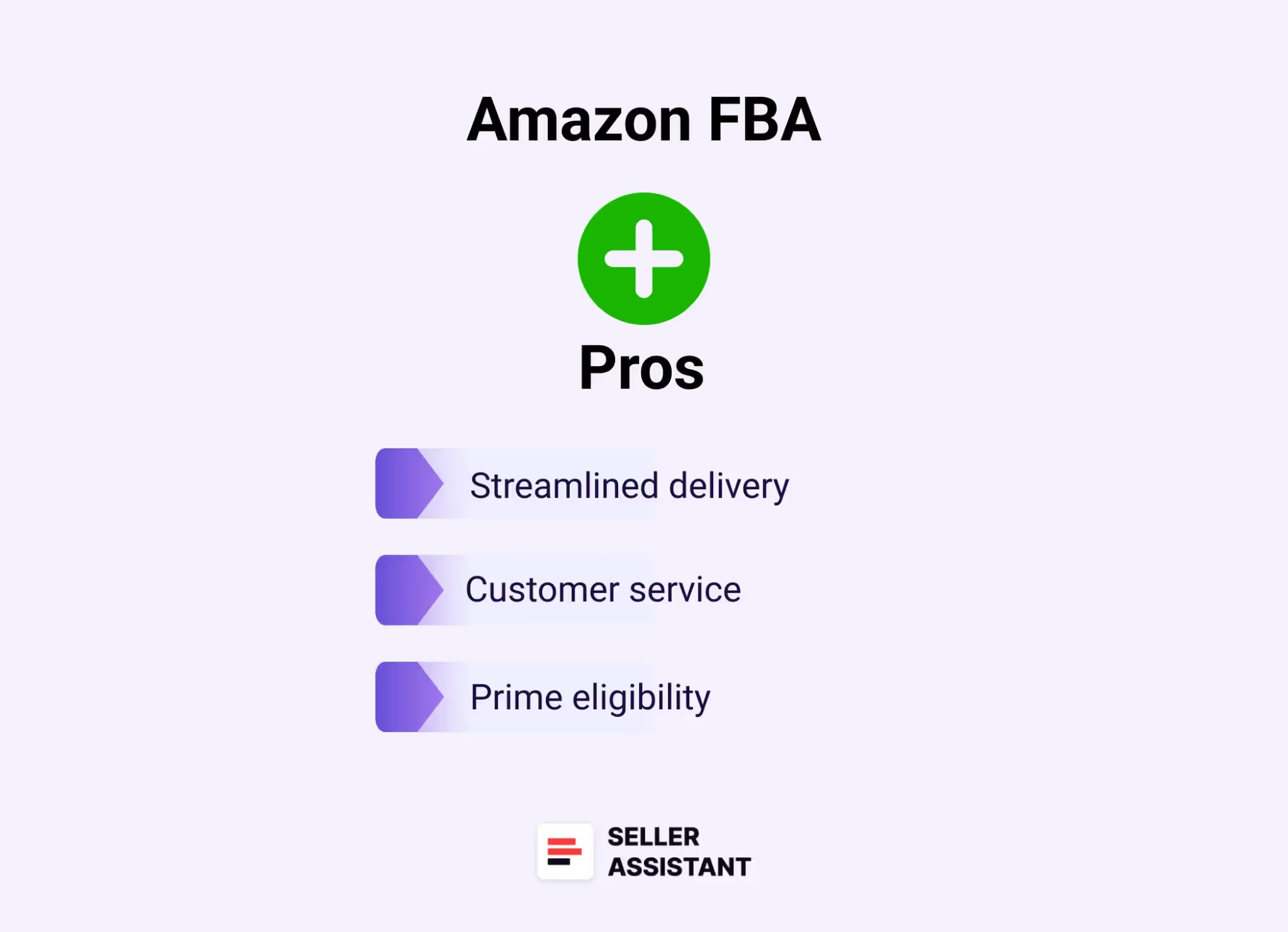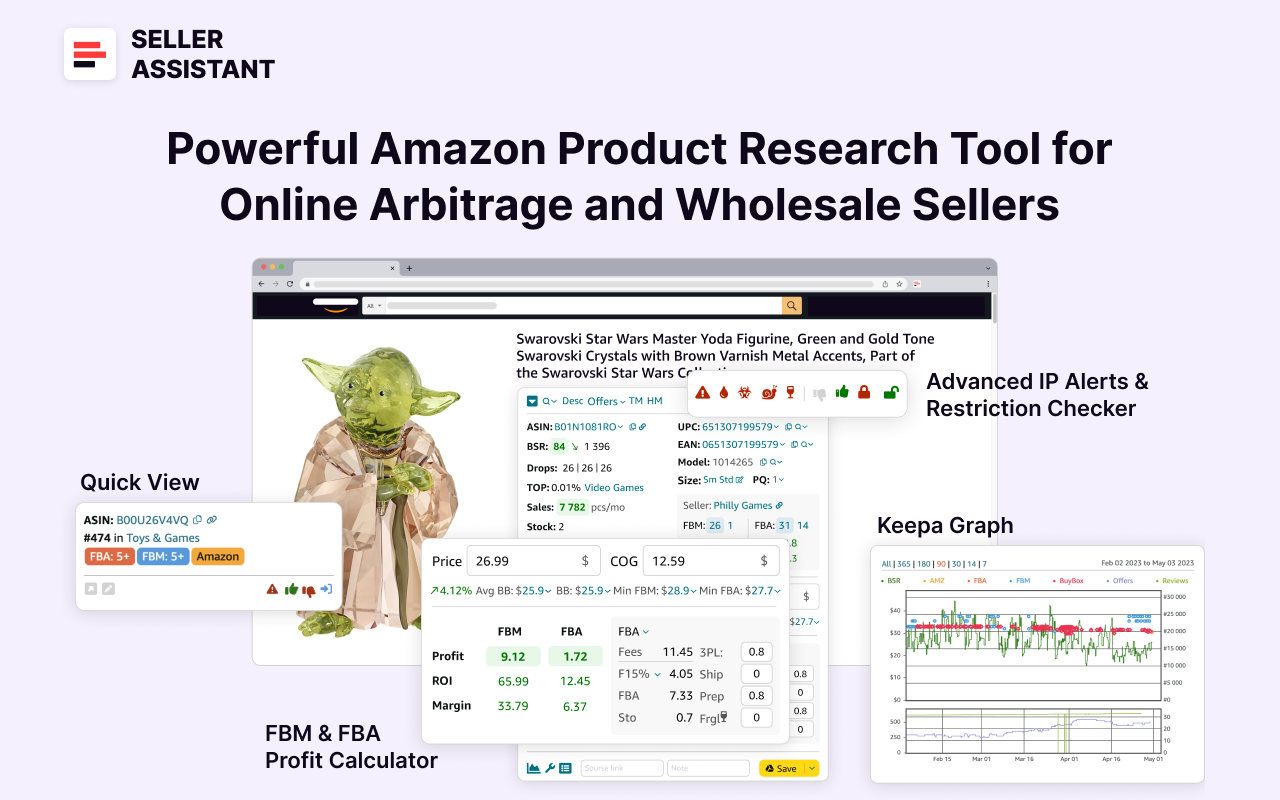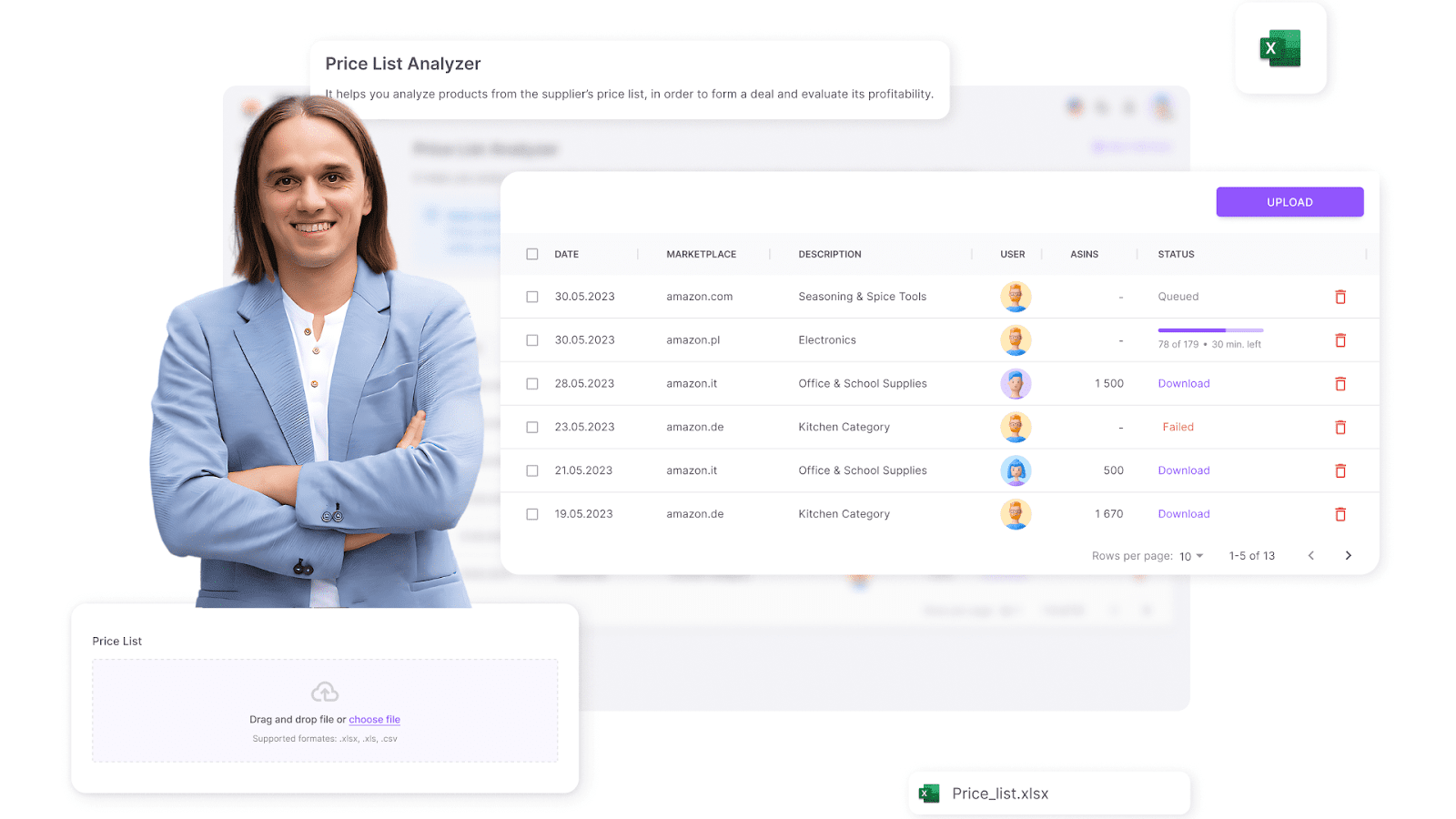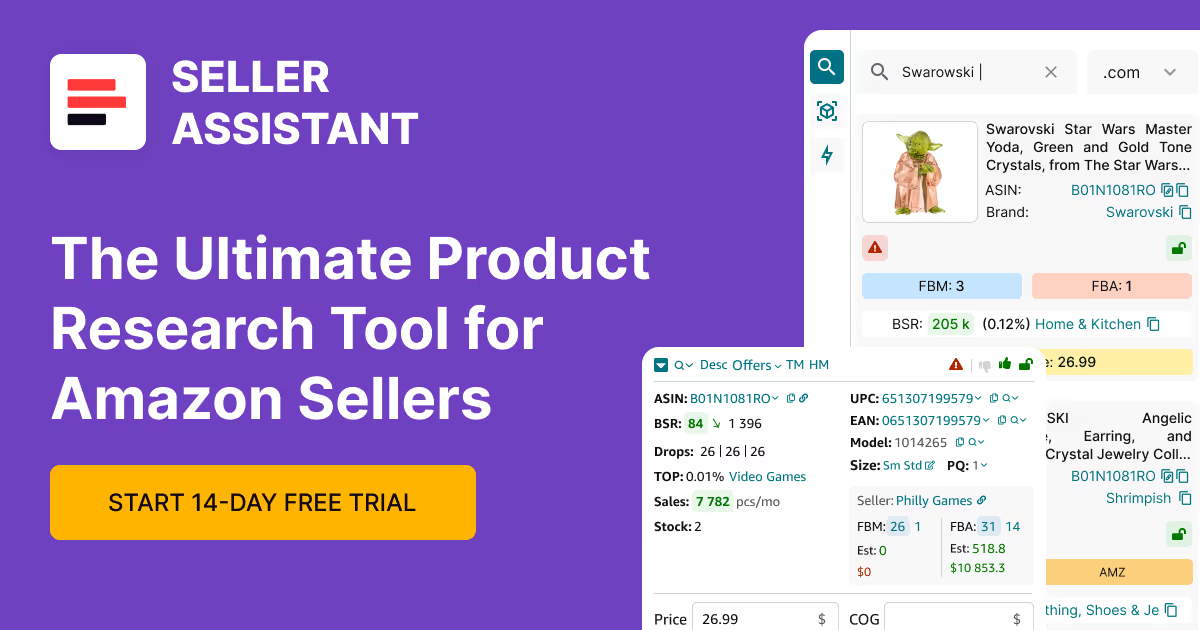Amazon FBA vs Dropshipping: which model to choose for a successful business
Download Amazon Seller Guide
This guide will help you get started, understand the basics of Amazon selling, and explain in simple words how it all works.

Stuck between Amazon FBA vs. dropshipping? You’re not alone. For new and seasoned sellers alike, picking the right business model can shape your success on Amazon.
Amazon FBA simplifies your life by storing, packing, and shipping products for you. Dropshipping, meanwhile, cuts out inventory altogether – products go from supplier to the prep center, and then straight to the customer. Each model has its perks and pitfalls, and what works best depends on your goals, budget, and how hands-on you want to be.
In this post, we’ll break down both models so you can make a smart, informed choice.
What Is Amazon FBA?
Amazon FBA, short for Fulfillment by Amazon, is a service that lets sellers outsource logistics to Amazon – for a fee. That means Amazon stores your inventory, packs orders, ships them out, and even handles customer service and returns.
It’s a go-to choice for many sellers because it simplifies operations and helps scale faster. Here’s exactly what it does.
.avif)
Overview of Amazon FBA services to sellers
Storage
You send your products to Amazon’s global network of fulfillment centers. This saves you space and ensures your items are close to customers for faster delivery.
Fulfillment
When a customer places an order, Amazon handles all the picking and packing. You don’t have to fulfill the order to the customer.
Shipping
Amazon ships your products quickly and efficiently, thanks to its vast logistics infrastructure. Your listings can also qualify for Prime, offering fast and free shipping to millions of members.
Customer service
Amazon takes care of customer inquiries, returns, and refunds. This removes a major time drain and helps keep buyers happy.
Related: 500+ USA Suppliers For Online Arbitrage And Dropshipping On Amazon
Best Product Ideas for Amazon FBA
How does Amazon FBA work?
When you set up a seller account on Amazon and choose a product to sell, you need to decide how you deliver the order to the customer – fulfillment method. You can either handle fulfillment yourself (Fulfillment by Merchant, FBM) or opt for FBA.
Choosing FBA means preparing and shipping your inventory to an Amazon fulfillment center, where Amazon stores your products until they are purchased. Upon purchase, Amazon’s staff packages and dispatches the item directly from their fulfillment center to the customer.
Amazon FBA in steps
- Step 1. Add your inventory to FBA
You start by adding your inventory to FBA through your Seller Central.
- For new products in your Seller Central account side menu, go to Catalog > Add Products, apply to sell the item, add product details, and choose the fulfillment method

- For existing products, go to Inventory > Manage All Inventory, click Edit, and then Change to Fulfilled by Amazon.

Related: Amazon Seller Central vs. Vendor Central: All You Need To Know
Do You Need a Business License to Sell on Amazon?
- Step 2. Prep and send inventory
Prepare, label, and package your products according to Amazon’s specifications to avoid delays and additional costs; then, ship them to an Amazon fulfillment center via the Send to Amazon process in your Seller Central.
- Step 3. Amazon stores your products
Once received, Amazon stores your items in their warehouse, with inventory levels trackable via your Seller Central.
- Step 4. A customer makes a purchase
When a product is ordered through FBA, Amazon processes the order.
- Step 5. FBA fulfillment
Amazon staff picks, packs, and ships your product, handling all customer service issues, including returns, refunds, and inquiries.
- Step 6. Payment
Amazon processes the customer’s payment, deducts FBA fees, and deposits the balance into your seller account.
- Step 7. Manage inventory
Maintain adequate inventory levels to avoid both stock-outs and excessive storage fees. Monitor, plan, and replenish your stock efficiently.
Related: How To Sell On Amazon Without Inventory?
What Are the Funding Options for Amazon Sellers?
What Is Amazon Dropshipping?
Amazon dropshipping is a business model where you sell products on Amazon without storing them and delivering to the customers yourself. Instead of keeping inventory, you purchase the product from a third-party supplier after a customer places an order – and the supplier ships it to a prep center, which then forwards it to the customer.
This detour through a prep center isn’t just logistical – it’s critical. Amazon’s strict dropshipping policy requires that you, the seller, are listed as the “seller of record” on all shipments. If your supplier ships directly to customers with their name on the packaging, you're violating this rule. Using a prep center ensures that all packages go out under your brand, helping you stay compliant and avoid account suspensions or listing removals.
Dropshipping appeals to many because it’s cheap and easy to start. You earn by marking up the supplier’s price and pocketing the difference, with low upfront costs and zero warehousing.
Here’s the Amazon dropshipping setup.
%20(1).avif)
Related: How to Sell on Amazon as an Individual Seller - Complete Guide
Amazon Online Arbitrage: How to Make Money
Amazon dropshipping parties
Seller
You’re the business owner. You list products on Amazon, handle customer service, and manage returns.
Supplier
This is the company you buy products from. They ship items to a prep center, not directly to customers.
Prep center
A third-party service that receives the product, removes any supplier branding, adds your label, and ships it to your customer.
Customer
The person who buys your product on Amazon. They never know a third-party supplier was involved.
Amazon
The platform you sell on. It connects you with customers but enforces strict policy rules to protect them.
Related: How to Sell on Amazon for Beginners - Complete Guide
Amazon Seller Compliance Documents
How does Amazon dropshipping work?
In dropshipping, you act as a bridge between customers and suppliers. You find profitable products to sell on Amazon that will be popular with the buyers and don’t have any potential risks or alerts. After that, you identify reliable suppliers to store and ship them.
When a customer buys something from you, you order it from the supplier who then delivers it to a prep center which repackages it to remove all signs of a third-party retailer, and sends the order directly to the customer. This way, you don't need to keep any inventory yourself.
Amazon dropshipping in steps
- Step 1. Open an Amazon seller account
Start by setting up your seller profile on Amazon. Choose between an Individual plan for fewer than 40 sales per month or a Professional plan if you expect more than 40 sales per month.
- Step 2. Research a product to sell
Identify a product that offers high-profit potential. Evaluate demand, competition, and profit margins. Utilize product sourcing software, Seller Assistant, to choose products that sell well and don’t have issues like IP alerts, restrictions, or other flags.
- Step 3. Find a reliable dropshipping supplier
Select a supplier who provides the desired product at a competitive price and is familiar with Amazon's prep and shipping standards. Ensure they have a solid reputation and reliable customer service.
- Step 4. List your product on Amazon
Add your offer to an existing listing on Amazon that matches your product. Go to Inventory > Add Products in your Seller Central account. Enter the product's ASIN, choose the condition, and list it for sale.
- Step 5. Receive an order
When a customer purchases your product, Amazon will alert you to the sale.
- Step 6. Order confirmation to the customer
Amazon automatically confirms the order with the customer, providing details such as the order number and estimated delivery date.
- Step 7. Forward the order to your supplier
Pass the order details, including product information and customer address, to your supplier.
- Step 8. Supplier ships the order
Your supplier locates the product, packages it following Amazon's standards, and dispatches it to the prep center.
- Step 9. Prep center repackages and sends the order
Prep center receives the order, removes supplier packaging, logos, invoices, etc., repackages it in your name, and sends it to the customer.
- Step 10. Customer receives their product
The customer receives their order directly from the supplier, completing the transaction without your direct involvement in handling the product.
Pros and Cons of Amazon FBA
Amazon FBA is a powerful tool, but it’s not a one-size-fits-all solution. It can simplify your business and boost customer satisfaction – but it comes at a cost.

Related: How to Create an Amazon Seller Central Account
Amazon Account Health: A Guide for FBA Sellers
FBA pros
Streamlined delivery
Amazon takes over the logistics – storage, picking, packing, and shipping – so you can focus on sourcing products and scaling your store. It’s a major time-saver, especially if you’re running lean.
Customer service
FBA sellers benefit from Amazon’s professional customer support. They handle inquiries, returns, and refunds, which means fewer headaches for you.
Prime eligibility
Your products become eligible for Amazon Prime, offering fast, free shipping to millions of shoppers. This can significantly boost your visibility and conversion rates.
Related: How to become an Amazon Top Rated Seller?
Amazon Seller Central: Complete Guide
FBA cons
.avif)
FBA fees
Amazon charges for storage and fulfillment, with costs based on item size, weight, and category. It’s essential to factor in these fees when calculating profit margins.
Long-term storage fees
If your inventory sits too long in Amazon’s warehouses, you’ll pay additional storage penalties. This can hurt sellers with slow-moving or seasonal stock.
Strict preparation guidelines
Amazon has rigid rules for labeling and prepping FBA inventory. Mistakes can lead to extra charges, delays, or even product rejection at the warehouse.
Pros and Cons of Amazon Dropshipping
Amazon dropshipping is a low-cost way to start selling online, but it’s not without risks. While you don’t need to invest in inventory or storage, the model comes with strict compliance requirements.
Many sellers face account suspensions for not following Amazon’s dropshipping policy – particularly when suppliers ship directly to customers. To stay compliant, most use a prep center to repackage products under their business name, though this adds extra operational cost.
Pros of Amazon dropshipping

Related: Amazon Global Selling: How to Sell Internationally
How to Send Products to Amazon FBA
Low initial costs
Dropshipping requires no upfront inventory purchases or storage fees. It’s one of the most affordable ways to start selling on Amazon, making it great for beginners or budget-conscious sellers.
No inventory management
Suppliers handle the storage and shipping of your products. This frees you up to focus on growing your business, not organizing a warehouse.
Seller tools help find products to sell
Finding winning products can be tough, but tools like Seller Assistant help you research faster and smarter. You can simply find hundreds of products and wait until your competitors sell out to sell at your price, because you don’t care about storage fees and don’t buy products until they are sold. They flag restricted items and potential IP risks so you can avoid costly mistakes.
Cons of Amazon dropshipping
.avif)
Related: 5 Strategies To Increase Amazon FBA Sales
13 Ways to Make Money on Amazon
Amazon dropshipping policy compliance
Amazon requires you to be the “seller of record,” meaning all packaging and documentation must carry your branding – not the supplier’s. This is typically resolved by routing shipments through a prep center, but using one adds extra steps and costs to your workflow.
Risk of intellectual property complaints
Selling branded products without authorization can trigger IP complaints. If you can’t prove your right to sell the item, you risk account suspensions and lost revenue. You can use Seller Assistant's IP Alert Extension to identify products with IP complaints.
Limited control over fulfillment and quality
You don’t handle the products yourself, so you can’t always guarantee shipping speed or product condition. Late deliveries or poor-quality items can lead to bad reviews and customer returns.
Related: How to Do Quick Amazon Product Research?
What is Fulfillment by Amazon (FBA)?
Difference Between Amazon FBA vs Dropshipping
Both Amazon FBA and dropshipping allow you to sell products without managing inventory yourself. But the way you source, fulfill, and manage orders – and the level of risk involved – differs significantly between the two.
Amazon FBA vs dropshipping: comparative table
.avif)
Amazon FBA vs. dropshipping
Inventory ownership
- FBA
With Amazon FBA, you buy products in bulk upfront and send them to Amazon's warehouses. This means you invest early – and risk losing money if products don’t sell.
- Dropshipping
With dropshipping, you only purchase a product after a customer places an order. This makes it a pay-as-you-go model with lower financial risk up front.
Fulfillment responsibility
- FBA
Amazon FBA handles the entire fulfillment process – picking, packing, and shipping – through its own warehouses. You don’t need to worry about how the product reaches the buyer.
- Dropshipping
In dropshipping, the supplier fulfills the order, often through a prep center to meet Amazon’s policies. You have little control over how fast or reliably that process works.
Storage and logistics
- FBA
Your inventory is stored in Amazon’s network of fulfillment centers, and you're charged for that space. This gives your products access to Prime shipping and faster delivery.
- Dropshipping
You don’t need to store products at all. Your supplier holds inventory and typically sends it through a prep center before it goes to the customer.
Customer service
- FBA
Amazon handles all customer service and returns for FBA orders. This offers a seamless experience for buyers and offloads that burden from you.
- Dropshipping
You’re responsible for customer service and handling returns. Even if the supplier is at fault, you’ll need to resolve complaints and coordinate refunds.
Upfront costs and cash flow
- FBA
You pay for inventory before making any sales, which can tie up your cash. This limits how many new products you can test without increasing your risk.
- Dropshipping
You pay your supplier only after the customer pays you. This gives you more cash flow flexibility and allows for wider product testing with minimal investment.
Control and flexibility
- FBA
You get more consistent delivery and customer service through Amazon’s system, but less flexibility when switching products or adjusting listings.
- Dropshipping
Dropshipping offers more freedom to pivot to different products quickly. But with that flexibility comes less control over fulfillment speed and product quality.

Which Model Should You Choose?
Choosing between Amazon FBA and dropshipping depends on your budget, business goals, and how hands-on you want to be. FBA is great for scaling with less day-to-day involvement, while dropshipping offers flexibility and low startup costs – ideal for experimenting or starting small.
When to go for FBA
You’re selling at volume
If you have strong or growing sales, FBA saves you time. Amazon handles the logistics so you can focus on scaling your business and sourcing new products.
You want to outsource logistics
FBA is perfect if you prefer a more automated setup. Amazon stores, ships, and even handles customer service – giving you more freedom from daily operations.
You lack a shipping setup
If you don’t have a reliable shipping partner, FBA fills the gap. You benefit from Amazon’s established logistics network and fast delivery.
You have limited storage space
No room to keep boxes? Amazon’s warehouses become your storage solution, keeping your operations lean and clutter-free.
Your products are standard
FBA works best with products that are easy to pack and ship – like small, non-perishable items. Oversized or heat-sensitive products may be better suited for third-party logistics.
When to go for dropshipping
You’re just starting out
Dropshipping keeps upfront costs low since you don’t need to buy inventory in advance. This makes it a great entry point for new Amazon sellers.
Your budget is tight
With no inventory or storage fees, dropshipping reduces financial risk. You can start selling even if your funds are limited.
You want to focus on research and testing
Without inventory management, you can spend more time identifying trends and finding profitable products. This is ideal for sellers who want to test the waters before committing.
You’re experimenting with products
Dropshipping lets you offer a broad range of items without worrying about unsold stock. It’s great for figuring out what resonates with your market.
You don’t have space
No shelves, no problem. Dropshipping completely removes the need for storage, making it easy to run your business from anywhere.
How to Find Profitable Deals for FBA and Dropshipping
Finding profitable products is the cornerstone of success whether you’re using Amazon FBA or dropshipping. Sellers use a mix of sourcing strategies – each suited to different levels of experience, inventory models, and business goals.
Below, we’ll break down the most effective methods and how to research products with Seller Assistant the right way for both fulfillment models.
Note. Seller Assistant is a comprehensive product-sourcing software that helps Amazon sellers quickly find high-profit deals. It combines three extensions: Seller Assistant Browser Extension, and IP-Alert Chrome Extension by Seller Assistant, and VPN by Seller Assistant, Amazon seller tools: Price List Analyzer, Brand Analyzer, Seller Spy, Bulk Restrictions Checker, and API integrations, and features: Side Panel View, FBM&FBA Profit Calculator, Quick View, ASIN Grabber, UPC/EAN to ASIN converter, Stock Checker, IP Alert, and Restrictions Checker.

Related: The Most Important Amazon Seller Metrics for FBA Businesses
2025 Important Dates Amazon FBA: Key Dates for Amazon Sellers
Seller Assistant shows all essential product data on Amazon search, product, and inventory pages, on supplier websites, and your competitor storefronts to help you find high-margin deals. By using this FBA and FBM product sourcing software, you can easily identify products that have the potential to be sold well on Amazon.
Strategy 1. Manual product sourcing
What it is
This method involves searching for specific deals where your supplier’s price is lower than the product’s selling price on Amazon. It’s a hands-on approach that gives you maximum control but can take more time to execute.
What you gain
Manually sourcing lets you carefully select products with great margins and lower risk. It gives you complete oversight of your decisions and allows you to focus on quality over quantity.
How it works
Explore retail websites for trending, low-risk products. Use the Seller Assistant Extension to access essential product data while browsing Amazon, supplier sites, search pages, or competitor storefronts.

How to research effectively
- Instantly view key product insights: sales speed, profit margin, competition, and selling restrictions
- Use Side Panel View to check real-time supplier vs. Amazon pricing
- Evaluate margins fast with Quick View on Amazon search results
- Detect risky items or brands with IP Alert
- Run profit breakdowns with the FBM&FBA Profit Calculator (includes logistics, fees, and taxes)
- Determine international VAT using the VAT Calculator
- Verify if a product can be sold using the Restriction Checker
- Avoid issues like meltable or bulky items using Seller Assistant’s risk alerts
- Use Sales Estimator to gauge product demand
- Check how much stock competitors are holding with Stock Checker
- Analyze variation performance using Variation Viewer
- Stay aware of price battles using the Offers feature
- Export your research into Google Sheets for better tracking
- Use Lookup Links to find matching suppliers across Google, eBay, Walmart, or Target
- Organize product notes and supplier comments in one place
- Review sales trends and price history with Keepa charts
Who it’s best for
- Sellers who want hands-on control over sourcing
- Newcomers learning product research basics
- Freelancers and VAs looking for profitable product leads
Read more: Seller Assistant Extension
New Dropshipping Strategy That Complies With Amazon’s Policy
Strategy 2. Automated supplier list scanning
What it is
This approach involves using automation to scan large product lists from suppliers quickly. It’s perfect for scaling sellers who manage hundreds of SKUs. Dropshippers and online arbitrage sellers who don’t have suppliers can parse supplier websites and automatically analyze results to find profitable deals.
What you gain
Automated tools speed up sourcing dramatically, identifying profitable and low-risk products in bulk. They also help detect issues like poor margins, brand restrictions, or excessive competition early on.
How it works
Fetch product lists from supplier websites. Upload them to Seller Assistant's Price List Analyzer to match them with Amazon listings.

The tool calculates profitability and populates your spreadsheet with key metrics like BSR, sales rate, competition level, Buy Box %, variation performance, and risk indicators (gated, hazmat, meltable, and more).

Related: Amazon Wholesale: All You Need To Know In
13 Rules of OA Product Research Tested by Pain and Gain of Amazon Seller
How to research effectively
- Measure market demand using BSR
- Avoid overcrowded listings with too many sellers or Amazon dominance
- Check Buy Box ownership to evaluate competitiveness
- Ensure your margins align with business goals
- Catch product restrictions, brand locks, and potential IP issues
Who it’s best for
- High-volume online arbitrage sellers
- Dropshippers who want to scan large supplier databases efficiently
Read more: Price List Analyzer by Seller Assistant
Strategy 3. Analyzing Competitor Best-Sellers
What it is
This method involves studying top sellers on Amazon to identify products and brands in high demand. It allows you to take inspiration from what’s already succeeding – reducing the trial-and-error phase.
What you gain
By keeping an eye on competitors, you can find products with a strong track record. This increases your chances of sourcing proven winners and cuts down on guesswork.
How it works
Activate Seller Assistant’s Seller Spy to monitor competitor storefronts. You’ll see what they’re selling, adding, removing, and how they’re pricing – giving you a blueprint for product sourcing.
.avif)
How to research effectively
- Track competitors’ new listings to identify rising trends
- Note which products they stop selling to avoid dead stock
- Analyze product reviews to gauge customer satisfaction
- Monitor pricing strategies to stay competitive without deep discounts
Who it’s best for
Dropshippers looking for proven, in-demand items
Read more: Seller Spy by Seller Assistant
Online Arbitrage for Beginners
Can You Use Dropshipping and FBA Together?
Yes, you can combine both Amazon FBA and dropshipping in your business strategy – and in many cases, it’s a smart move. This hybrid approach allows you to take advantage of the strengths of both models while minimizing their downsides. Here's how it works.
FBA for fast-moving products
Use Amazon FBA for your best-selling or high-demand items. By sending these products to Amazon’s warehouses, you benefit from Prime eligibility, faster delivery times, and hands-off logistics – making it easier to scale while keeping customers satisfied.
Dropshipping for slower-moving or niche products
For items that sell less frequently or cater to a specific niche, dropshipping is more cost-effective. It lets you avoid upfront inventory purchases and storage fees, reducing your risk while still offering a wide product selection to your customers.
FAQ
Is dropshipping legal?
Yes, dropshipping is legal on Amazon as long as you comply with Amazon’s dropshipping policy. This includes identifying yourself as the seller of record and ensuring there’s no supplier branding on the product or packaging.
How to dropship on Amazon without money?
To dropship on Amazon with minimal upfront investment, use suppliers that don’t require buying inventory in advance. However, you may still need to pay for software tools, a prep center, and a professional seller account.
How to find low competition products on Amazon?
Use product sourcing tools like Seller Assistant to filter items with low seller count, healthy margins, and strong demand. Analyze competition levels, Buy Box rotation, and customer reviews to identify profitable gaps in the market.
Should I choose Amazon FBA or dropshipping?
Choose Amazon FBA if you want to scale faster and automate fulfillment with better shipping and customer service. Go with dropshipping if you're starting out with limited funds or want to test product ideas with minimal risk.
Can I use Amazon FBA for dropshipping?
You can’t use Amazon FBA to fulfill orders from another retailer – that violates Amazon’s dropshipping policy. However, you can use dropshipping as a sourcing method and ship products to Amazon for FBA processing.
Is Amazon FBA or dropshipping better?
Amazon FBA offers greater scalability and a smoother customer experience, but requires more upfront investment and inventory risk. Dropshipping is more flexible and cheaper to start but has less control over shipping and quality.
Final Thoughts
Choosing between Amazon FBA and dropshipping comes down to your goals, budget, and how much control you want over your business. FBA offers speed, scalability, and automation – perfect for sellers ready to invest and grow.
Dropshipping is flexible, low-cost, and ideal for testing products without upfront risk. You can even combine both models to maximize efficiency and expand your product range.
Whichever path you choose, the key to success lies in smart product sourcing with Amazon seller tools like Seller Assistant's tools to quickly and effortlessly find profitable deals.
Seller Assistant is an all-in-one product sourcing software offering all the features vital for product sourcing. It combines three extensions: Seller Assistant Extension, IP Alert, and VPN by Seller Assistant, tools: Price List Analyzer, Brand Analyzer, Seller Spy, Bulk Restrictions Checker, and API integrations, and features: Side Panel View, FBM&FBA Profit Calculator, Quick View, ASIN Grabber, UPC/EAN to ASIN converter, Stock Checker, and other features that help quickly find high-profit deals. Seller Assistant also offers integration with Zapier allowing to create custom product sourcing workflows.

.svg)













